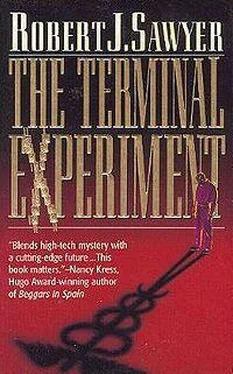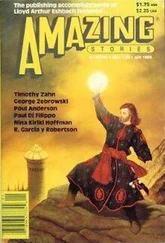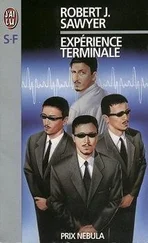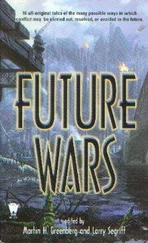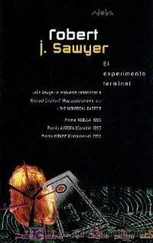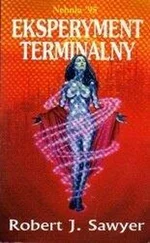“What’s this?” said Peter, pointing to a monitor in Mirror Image’s computer lab showing what appeared to be a school of small blue fish swimming through an orange ocean.
Sarkar looked up from his keyboard. “Artificial life. I’m teaching a course about it at Ryerson this winter.”
“How’s it work?”
“Well, just as we’ve simulated your mind within a computer, so too is it possible to simulate other aspects of life, including reproduction and evolution. Indeed, when the simulations get sufficiently complex, some say it’s only a question of semantics as to whether the simulations are really alive. Those fish evolved from very simple mathematical simulations of living processes. And, like real fish, they exhibit a lot of emergent behaviors, such as schooling.”
“How do you get from simple math to things that behave like real fish?”
Sarkar saved his work and moved over to stand next to Peter. “Cumulative evolution is the key — it makes it possible to go from randomness to complexity very quickly.” He reached over and pushed some keys. “Here, let me give you a simple demonstration.”
The screen cleared.
“Now,” said Sarkar, “type a phrase. No punctuation, though — just letters.”
Peter considered for a moment, then pecked out, “And where hell is there must we ever be.” The computer forced it all to lowercase.
Sarkar glanced over his shoulder. “Marlowe.”
Peter was surprised. “You know it?”
Sarkar nodded. “Of course. Private school, remember? From Doctor Faustus : ‘Hell hath no limits, nor is circumscribed in one self place, for where we are is hell, and where hell is there must we ever be.’ ”
Peter said nothing.
“Look at that phrase you typed — it consists of 39 characters.” Sarkar hadn’t counted; the computer had reported the number as soon as Peter had finished typing, as well as several other statistics. “Well, think of each of those characters as a gene. There are 27 possible values each of those genes could have: A through Z, plus a space. Since you typed a 39-character string, that means there are 27 to the 39th power possible different strings of that length. Oodles, in other words.”
Sarkar reached over and pressed a few keys. “This workstation,” he said, “can generate a hundred thousand random 39-character strings each second.” He pointed to a number on the screen. “But even at that rate, it would take 2x1043 years — trillions of times longer than the whole lifetime of the universe — to hit that entire, precise string of Marlowe you typed by pure random chance.”
Peter nodded. “It’s like the monkeys.”
Sarkar sang: “Here we come…”
“Not the Monkees. The infinite number of monkeys banging away on keyboards. They’ll never produce an exact copy of Shakespeare, no matter how long they try.”
Sarkar smiled. “That’s because they’re working at random. But evolution is not random. It is cumulative. Each generation improves on the one that preceded it, based on selection criteria imposed by the environment. With cumulative evolution, you can go from gibberish to poetry — or from equations to fish, or even from slime mold to human beings — amazingly fast.” He touched a key and pointed at the screen. “Here’s a purely random thirty-seven-character string. Consider it an ancestral organism.” The screen showed:
000 wtshxowlveamfhiqhgdiigjmh rpeqwursudnfe
“Using cumulative evolution, the computer can get from that random starting point to the desired ending point in a matter of seconds.”
“How?” asked Peter.
“Say that every generation, one text string can produce thirty-nine offspring. But, just as in real life, the offspring are not exactly the same as the parent. Rather, in each offspring, one gene — one character — will be different, moving up or down the alphabet by one: a Y can become an X or a Z, for instance.”
“Okay.”
“For each of the thirty-nine offspring, the computer finds the one that is best suited to this environment — the one that is closest to Marlowe, our ideal of a perfectly adapted life form. That one — the fittest — is the only one that breeds in the next generation. See?”
Peter nodded.
“Okay. We’ll let evolution run its course for a generation.” Sarkar pushed another key. Thirty-nine virtually identical strings appeared on screen, and a moment later thirty-eight of them winked out. “Here’s the fittest offspring.” He pointed at the screen:
wtshxowlveamfhiqhgdiigjmh rpeqwursudnfe
wtshxowlvdamfhiqhgdiigjmh rpeqwursudnfe
“It is not obvious,” said Sarkar, “but the lower string is marginally closer to your target than the original.”
“I can’t see a difference,” said Peter.
Sarkar peered at the screen. “The tenth character has changed from E to D. In the target, the tenth character is a space — the space between ‘where’ and ‘hell.’ We’re using a circular alphabet, with space as the character between Z and A. D is closer to a space than E is, so this string is a slight improvement — slightly fitter.” He pushed another key. “Now, we’ll let it run through to the end — there, it’s done.”
Peter was impressed. “That was fast.”
“Cumulative evolution,” said Sarkar, triumphantly. “It took only 277 generations to get from gibberish to Marlowe — from randomness to a complex structure. Here, I’ll just display every thirtieth generation, with genes that have evolved to their target values in upper case.”
Keyclicks. The screen showed:
000 wtshxowlvdamfhiqhgdiigjmh rpeqwursudnfE
030 wttgWoxmvdakgiiphfdHghili STerwuotucneE
060 xrtgWoymwccigihpiddHfihll STesxuovvapdE
090 xqugWm nzccfhihomcdHfihkM STcuyunvvzpdE
120 ypudWl p bcEijhmnbbHfihkMzSTbWyvmvwyrcE
150 zpvdWj R aeEjlhlqbzHfigkMyST WyvkvwvsBE
180 AozcWibR fEklhkrbyHEjgiMxST W wjvwtuBE
210 ANzaWHERd HELLhISawHEjEiMwST WbwgvxsuBE
240 AND WHERE HELLfIS THEnEiMUST WdwEVzszBE
270 AND WHERE HELLcIS THEREbMUST WE EVER BE
He pressed a couple more keys. “And here are the last five generations.”
AND WHERE HELLcIS THEREaMUST WE EVER BE
AND WHERE HELLbIS THEREaMUST WE EVER BE
AND WHERE HELLalS THEREaMUST WE EVER BE
AND WHERE HELLalS THERE MUST WE EVER BE
AND WHERE HELL IS THERE MUST WE EVER BE
“That’s neat,” said Peter.
“It is more than just neat,” said Sarkar. “It is why you and I and the rest of the biological world are here.”
Peter looked up. “You surprise me. I mean, well, you’re a Muslim — I assumed that meant you were a creationist.”
“Please,” said Sarkar. “I am not fool enough to ignore the fossil record.” He paused. “You were raised a Christian, even if you don’t practice that faith in any meaningful way. Your religion says we were created in God’s image. Well, that’s ridiculous, of course — God would have no need for a belly button. What ‘created in His image’ means to me is simply that He provided the selection criteria — the target vision — and the form we evolved to take was one that was pleasing to Him.”
And so, at last, Peter Hobson’s story and Sandra Philo’s story had converged, the death of Hans Larsen — and the other murder attempts that were to come — drawing their lives together. Sandra worked at integrating Peter’s memories with her own of that time — piecing the puzzle together, bit by bit…
Читать дальше
